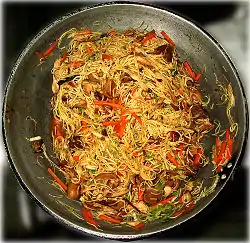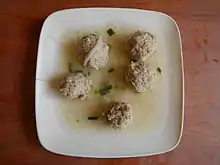Misua
Misua (Chinese: 麵線; Pe̍h-ōe-jī: mī-sòaⁿ), also spelled mee sua or miswa, are a very thin variety of salted noodles made from wheat flour.[1] It originated in Fujian, China.[1] The noodles differ from mifen (rice vermicelli) and cellophane noodles in that those varieties are made from rice and mung beans, respectively.
 Fried misua noodles | |
| Type | Chinese noodles |
|---|---|
| Place of origin | China |
| Region or state | Fujian |
| Main ingredients | Wheat flour |
| Misua | |||||||||||
|---|---|---|---|---|---|---|---|---|---|---|---|
| Traditional Chinese | 麵線 | ||||||||||
| Simplified Chinese | 面线 | ||||||||||
| Literal meaning | noodle threads | ||||||||||
| |||||||||||
Description
Misua is made from wheat flour.[2] Cooking misua usually takes less than two minutes in boiling water, and sometimes significantly less.

Culture
Misua is cooked during important festivities, and eaten in mainland China as well in Cambodia, Taiwan, Malaysia, Indonesia, Singapore, Vietnam, Brunei, Thailand, and the Philippines. Misua signifies long life in Chinese culture, and as such is a traditional birthday food.
It is usually served with ingredients such as eggs, oysters,[2] pig's large intestine,[2] shiitake mushroom, beef, shallots, or scallions, roasted nuts or fried fish.
In Taiwan, there are two forms of misua. The first is plain, while the second has been steamed at high heat, caramelizing it to a light brown colour. For birthdays, plain misua is usually served plain with pork hocks (猪腳麵線) in stewed broth as a Taiwanese birthday tradition. Brown misua can be cooked for prolonged periods without disintegrating in the cooking broth and is used in oyster vermicelli (蚵仔麵線), a dish popular in Taiwan.
References
- Albala, K. (2017). Noodle Soup: Recipes, Techniques, Obsession. University of Illinois Press. p. 173. ISBN 978-0-252-05019-0. Retrieved August 26, 2018.
- Cosmo, S. (2017). The Ultimate Pasta and Noodle Cookbook. Cider Mill Press. p. 92. ISBN 978-1-60433-733-4. Retrieved 4 January 2020.

